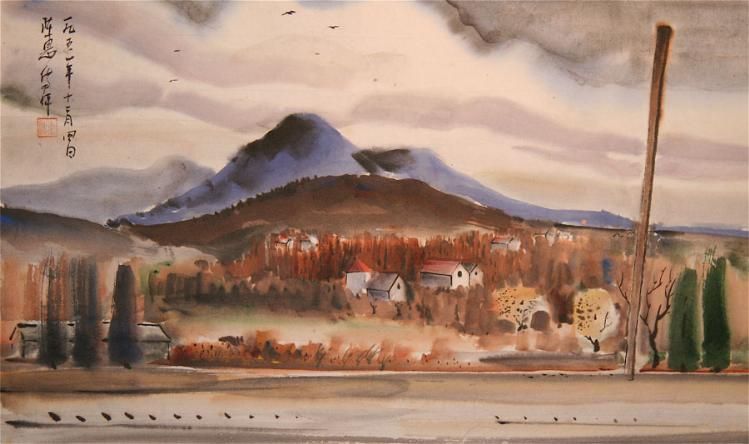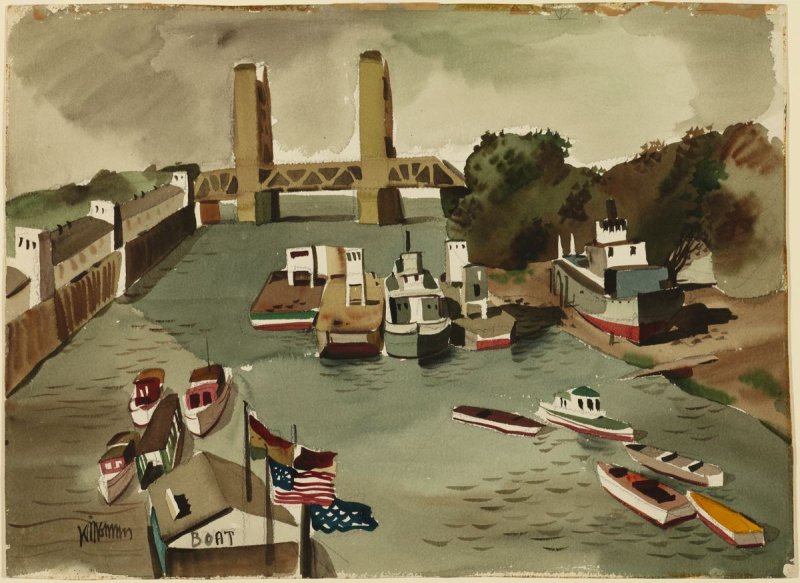Last month I talked about the historiographic essay I worked on for Modern US. Today, I’ll talk about the essay I’ve been working on for Ethnic Modernism. As I mentioned in a previous post, this has primarily been a literature course, but I’ve been using this paper as an opportunity to take a closer look at exhibition schedule of the Roswell Museum Federal Art Center, and more specifically one show called FAP-#560, Two Chinese American Artists. Here’s a condensed version of the introduction:
“In May 1941, a watercolor exhibition organized by the Federal Art Project (FAP) traveled by train from Washington, DC, to the Roswell Museum Federal Art Center in New Mexico. Referred to as FAP #560 in federal paperwork, the watercolor show was one of many traveling exhibitions associated with the Federal Community Art Center Project. For the Roswell Museum, the prospect of receiving and exhibiting a contemporary watercolor show from the FAP had become a regular part of its operations, and if nothing else, the framed paintings would be among the easier group of objects to unpack and hang.

What made FAP #560 unusual as a traveling exhibition, however, was not the objects constituting its checklist, but its emphasis on the ethnicity of its contributing artists. It featured the work of two watercolorists, Dong Kingman of Oakland, California, and Fay Chong of Seattle, Washington, both of whom worked for the FAP and achieved critical success as watercolorists. Even more strikingly, the exhibition description accompanying the show asserted the positive contributions of immigrants to the American art scene, stating that “The contributions of the emigrant is vast and varied and scarcely to be estimated.” In a political climate often noted for its isolationist, xenophobic policies, the FAP’s decision to both highlight work from Asian Americans and call attention to their ethnicity as such initially seems radical. A closer consideration of this emphasis, however, underscores the ambivalence underpinning the FAP’s navigation of America’s ethnic art scenes.

This paper considers the significance of Two Chinese American Artists in relation to the exhibition practices of the FAP and the perception of Asian American artists in the United States. In comparison to the FAP’s other traveling exhibitions, FAP #560’s emphasis on the Chinese heritage and immigrant affiliations of Kingman and Chong suggest a willingness to acknowledge the positive contributions of ethnic artists to the American art scene. The predominantly American subject matter of the works themselves, moreover, which all feature titles in English rather than Chinese, suggest the successful assimilation of the two artists into the American art scene, with Kingman and Chong both creating place-based work reflecting the tenets of contemporary Regionalist movements. At the same time, however, the FAP’s emphasis on Kingman and Chong’s ethnic background highlights their otherness as immigrants or the descendants of immigrants. Additionally, the FAP’s description, intentionally or not, elides the regionally distinct California and Seattle art circles in which they worked into a single Asian American art scene, with ethnicity being the defining visual characteristic. While the exhibition’s tone is ultimately celebratory, it presents Kingman and Chong as foreigners first, American regionalists second. “

This has been a fun project to work on for a variety of reasons. On the one hand, it’s been a good opportunity to begin analyzing the content of the exhibition content of the Community Art Center Project, and to start thinking critically about the kinds of works featured in thee shows. It’s also allowed me to begin confronting the kinds of challenges I’ll be dealing with as I start looking at the Community Art Center Project exhibitions. Although I have a checklist for FAP-#560, for instance, I don’t have any images of the works, I don’t know their current whereabouts, and I’m not sure that they still go by the titles listed in the museum paperwork. In other words, works exhibited through the Community Art Center Project will likely be tricky to track down. While I’ll have more time to track down pieces when I’m working on the actual dissertation, in the meantime I’ve been looking up comparable examples for Kingman and Chong in collections online, books, and other places. They may not be the exact pieces on the checklist, but they’re close.
I’ve been thinking about speculative history since attending a lecture by Krista Thompson about artist and activist Tom Lloyd earlier this spring. Toward the end of the lecture, she posed several questions, not about Lloyd’s work as we know it, but rather his unfinished or incomplete projects, and invited the audience to speculate about these pieces with her. She also asked about us to think about the kinds of documents that hadn’t been preserved over the years, and what such an archive would look like if these lost documents were to be recovered. Ultimately it was all speculative, but thinking about invisible archives encouraged us to think beyond conventional archives and consider the kinds of sources that don’t get preserved in them.
I don’t know how this essay will exactly play into my dissertation, but it’s definitely been a good exercise in thinking about framing it. I’ve also had the opportunity to learn more about the work of two artists I had never heard of before now, as well as become acquainted with some of the art scenes in California and Seattle. All in all, I’d consider it a success.